

University of Idaho Extension. Big Game from Hunt to Home > PDFFor your next hunting trip, the information in this publication will make sure the meat you bring home will be high quality.

Meat from big game animals (deer, antelope, elk, moose, and bear) is a nutr . . . . . University of Idaho Extension. University of Idaho Extension Shopping Cart University of Idaho Extension Extension Publishing Physical Address: E.
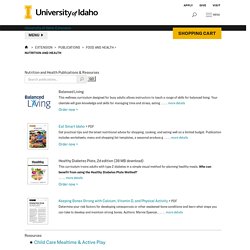
J. Mailing Address: 875 Perimeter Drive MS 2332 Moscow, ID 83844-2332 Phone: 208-885-7982 Fax: 208-885-9046 Email: calspubs@uidaho.edu Location Nutrition and Health Publications & Resources Balanced Living This wellness curriculum designed for busy adults allows instructors to teach a range of skills for balanced living. Order now > Eat Smart Idaho > PDF Get practical tips and the latest nutritional advice for shopping, cooking, and eating well on a limited budget. Order now > Healthy Diabetes Plate, 2d edition (38 MB download) This curriculum trains adults with type 2 diabetes in a simple visual method for planning healthy meals. Root cellar how to build. Before refrigeration, the root cellar was an essential way to keep carrots, turnips, beets, parsnips, potatoes, and other root vegetables fresh through the winter months.

If you have snowy, wintery conditions, this time-tested storage method still makes sense today—whether you stock a root cellar with your own homegrown produce or the bounty from local farmers' markets. What is a Root Cellar? Technically, a root cellar is any storage location that uses natural cooling, insulating, and humidifying properties of the earth. How to store garden vegetables for winter. WE TALKED ABOUT storing tender ornamental plants recently, but what about garden vegetables, now that colder nights and days are here?
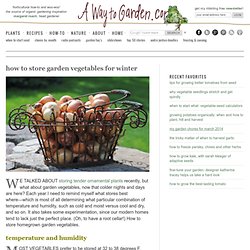
Each year I need to remind myself what stores best where—which is most of all determining what particular combination of temperature and humidity, such as cold and moist versus cool and dry, and so on. It also takes some experimentation, since our modern homes tend to lack just the perfect place. (Oh, to have a root cellar!) How to store homegrown garden vegetables. temperature and humidity MOST VEGETABLES prefer to be stored at 32 to 38 degrees F. Harvesting and storing home garden vegetables : Vegetables : Yard and Garden. Extension > Garden > Yard and Garden > Vegetables > Harvesting and storing home garden vegetables Cindy Tong, Extension post-harvest horticulturist One of the joys of summer is homegrown sweet corn, picked right outside your back door and plopped straight into a pot of boiling water or onto the grill.
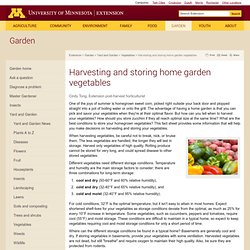
The advantage of having a home garden is that you can pick and savor your vegetables when they're at their optimal flavor. But how can you tell when to harvest your vegetables? How should you store zucchini if they all reach optimal size at the same time? P. Allen Smith Garden Home. It seems like the higher the temperatures rise some of the vegetables perform better than others and nothing likes the heat better than okra.
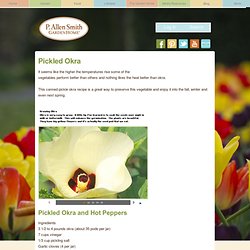
This canned pickle okra recipe is a great way to preserve this vegetable and enjoy it into the fall, winter and even next spring. Ingredients 3 1/2 to 4 pounds okra (about 35 pods per jar) 7 cups vinegar 1/3 cup pickling salt Garlic cloves (4 per jar) Hot peppers, stems removed (2 per jar) Dill Sterile pint jars with lids Directions: Bring the vinegar and pickling salt to a boil. Drop a few garlic cloves and 2 hot peppers.
Pack the jar with orka. Place the jar in a large bowl and ladle in the hot pickling liquid. Screw on a lid. The jars need to be processed in a hot water bath. Remove the jars from the hot bath with tongs. To learn more about how to use a water bath safely visit the USDA's website on the subject at This article is brought to you by Bonnie Plants. How Do I? Pickle. GH1459 Quality for Keeps: Pack a Pickled Product. Food Preservation Team Nutritional Sciences Sauerkraut 25 pounds cabbage 3/4 cup canning or pickling salt Yield About 9 quarts Quality Firm heads of fresh cabbage make the best sauerkraut.

GH1452 Quality for Keeps: Steps to Success in Home Canning. Food Preservation Team Nutritional Sciences Your home-canned products will be only as good as the fresh foods you start with.
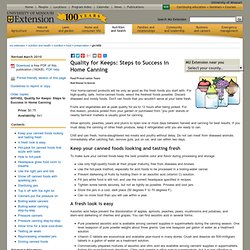
For high-quality, safe, home-canned foods, select the freshest foods possible. Discard diseased and moldy foods. Don't can foods that you wouldn't serve at your table fresh. Fruits and vegetables are at peak quality for six to 12 hours after being picked. Allow apricots, peaches, pears and plums to ripen one or more days between harvest and canning for best results. Chill and can fresh, home-slaughtered red meats and poultry without delay. Keep your canned foods looking and tasting fresh To make sure your canned foods keep the best possible color and flavor during processing and storage: Use only high-quality foods at their proper maturity, free from diseases and bruises. A fresh look is easy Ascorbic acid helps prevent the discoloration of apples, apricots, peaches, pears, mushrooms and potatoes, and stem-end darkening of cherries and grapes.
GH1451 Quality for Keeps: Before You Start to Can, Learn the Basics. Food Preservation Team Nutritional Sciences Canning preserves food by using heat to destroy the microorganisms that cause spoilage.
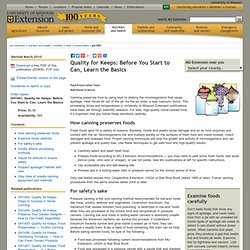
Heat forces air out of the jar. As the jar cools, a seal (vacuum) forms. The processing times and temperatures in University of Missouri Extension publications have been set through scientific research.